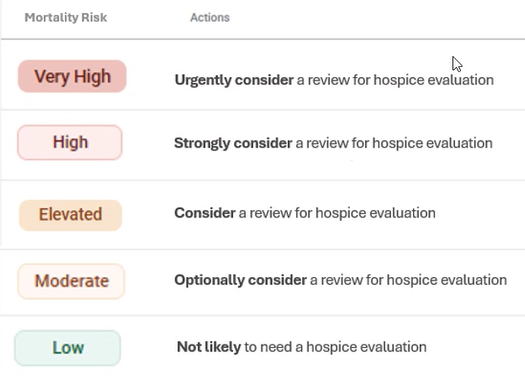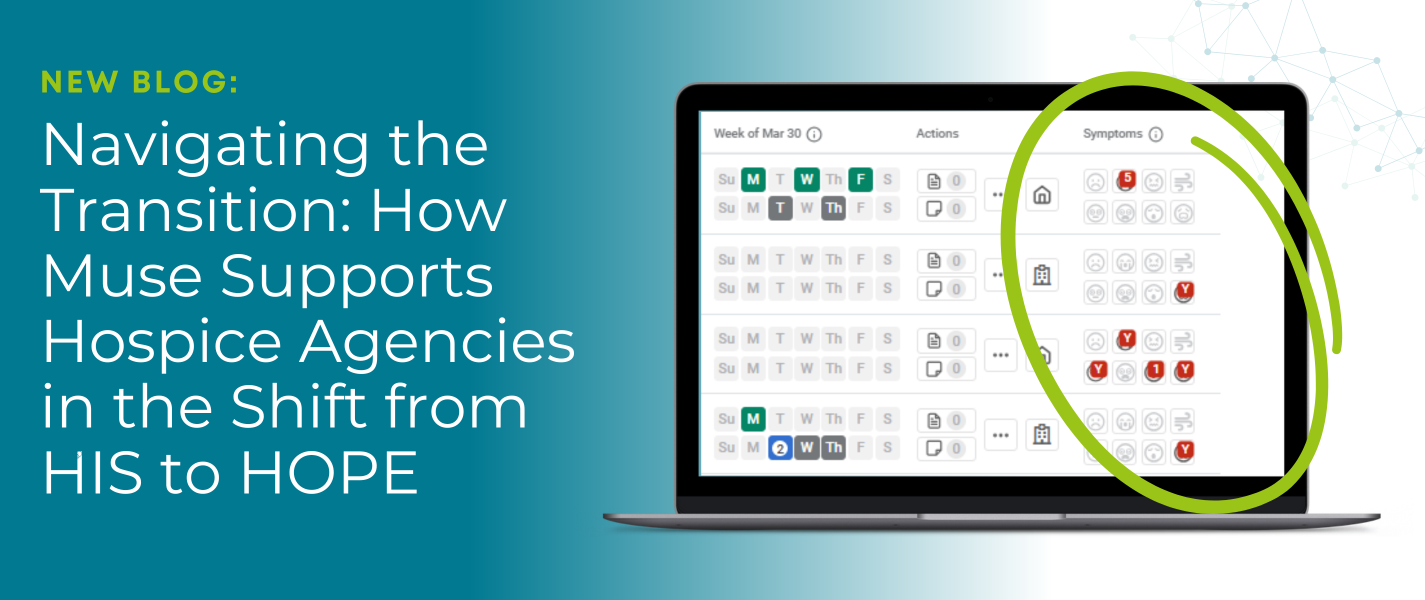Predictive analytics improve hospice transition evaluations for better patient care.
As patients approach the final months of their lives, their needs change and begin to extend to their loved ones as well. Hospice care is structured to provide more holistic physical, emotional, and spiritual support for patients and their families. Because of this, it’s important for home health agencies to consistently and timely evaluate patients for hospice care, and to have the support necessary to make and substantiate clinically informed decisions. Pulse Transitions is an invaluable partner in applying breakthrough mortality risk modeling to prioritize and facilitate hospice evaluations rooted in clinical evidence.
Patient evaluations often aren’t consistent, thorough, or timely enough.
The goal of any care team across home health and hospice, particularly as the ongoing shift towards value-based care continues, is to ensure quality, patient-centered care that improves outcomes wherever possible. Meeting this goal requires consistent evidence-based evaluation of all patients, but this is difficult to achieve in practice without help. The data-intensive environment agencies must navigate makes it challenging to evaluate patients with higher acuity in a timely, thorough manner that accurately appraises risk of mortality. Without the right technology, clinicians must either superficially evaluate all patients or taking a scattershot approach at deeper review. Unfortunately, these approaches can lead to either (i) missing the right patients or (ii) overlooking key data without knowing where to look. Quality of care and outcomes can suffer as a result.
In addition, communication between home health and transition-focused teams can be challenging, particularly with siloed patient data. Transition navigators may see the need for a potential patient transition from their viewpoint, but clinical managers may not have access to the same data informing this decision or a full view of the evaluation process navigators go through.
These challenges ultimately lead to far too many patients spending too much time in home health, when hospice care would likely serve them better. In some cases, agencies’ failure to act or accurately evaluate risk causes patients to miss out on hospice care entirely. We know that 54% of hospice patients receive less than 30 days of their hospice benefit, leaving on the table a better care experience in a time of need. Home health teams are trained differently than hospice teams and generally aren’t equipped to do everything a patient with high mortality risk may require, particularly as they draw closer to death. This makes it imperative that patients make timely transitions to hospice.
Predictive mortality risk modeling offers a compelling path to accurate, timely reviews and decisions for high-risk patients.
The decision to evaluate a patient for hospice should ideally be made because of an elevated mortality risk, not at random or as part of a cursory review of the full census. Appraisal of patient mortality risk must be consistent and reliable. After an evaluation is performed, actions to be taken should be clear, and decisions made should be substantiated by evidence from the clinical record. In this way, agencies can be confident that those patients whose risk profile necessitates evaluation are being accurately evaluated and subsequently provided care solutions that meet their needs.
Unassisted human evaluation of mortality risk often isn’t up to this challenge. A reviewer may not have enough time for in-depth reviews because of a large census or may miss some key data. Enter Pulse Transitions, which brings agencies mortality risk modeling rooted in robust data science, offering a stronger starting point for patient review. Each patient receives a visit-by-visit mortality risk prediction based on comparison of that patient against a broadly representative patient data set. These risk levels then serve as a foundation for evidence-based recommendations that help care teams prioritize evaluation of the right patients at the right time so they can spend more time in the right setting.
Pulse Transitions drives consistent review of the right patients
By consistently reviewing the right patients, agencies act more responsively to increased patient needs in higher-risk patient groups. The nature of hospice care is fundamentally different from home health and allows for more holistic physical, emotional, and familial support better aligned to patients’ needs near death. Those patients whose acuity and risk levels align with a hospice profile have more resource-intensive needs. When these needs go unmet, hospitalizations and deaths on the home health census rise.
In addition, it’s important that agencies allocate resources effectively across the home health census. When significant numbers of patients who would be better served by hospice care remain in home health, the whole patient group can be impacted, and the agency stretched too thin. The United States DHHS found that 35-54% of nurses report burnout, so this makes a big problem worse.
Pulse Transitions presents high-risk patients for review and easy action, highlighting them both in the patient census and in individual patient pages. Each patient has a mortality risk prediction based on comparison of that patient’s data against a broadly representative patient data set, not just data from an individual branch. This ensures that branches with a higher-risk patient population see appropriate recommendations for all patients. If a patient’s data include several points that our data science has shown to correspond to high mortality, their risk level and review recommendation will reflect this. Each mortality risk level corresponds to a recommended action:

These mortality risk groupings break down by how much more likely patients are than the baseline to die in the next 60 days. If a patient falls in the “high” or especially “very high” grouping, their mortality risk is several times higher than those in the “low” grouping. Most patients in the typical branch will fall in the low-risk category, which allows agencies to focus their limited evaluation time on those whose risk profile supports the need for review.

By presenting review recommendations in line with risk, Transitions brings the right patients into focus. Recommendations are backed up by data surfaced from the patient record that substantiates the strength of each patient’s candidacy for hospice. In addition, recent updates have brought more patient data than ever to Transitions users directly in the product, instead of having to jump into the EMR for most review needs. In short, Transitions identifies patients whose mortality risk requires review, recommends action based on risk, and facilitates action with data.
Transitions helps agencies more consistently get the timing right
In addition to helping agencies focus on the right patients, Pulse Transitions surfaces these patients at the right time. Because a patient’s condition and needs can change so rapidly, it’s imperative that agencies choose a technology partner that accounts for the most up-to-date picture of each patient. Part of the struggle with understanding and acting on patient risk in a timely manner is that agencies are either (i) not using technology for targeted, risk-based patient evaluation or (ii) using an outdated solution that only updates recommendations with every OASIS. This leaves care teams in the dark and inevitably misses patients.
Mortality risk models, and the recommendations that use them as a foundation, are only as useful as the data they consider. Transitions is unique in making individualized patient recommendations that consider visit-by-visit patient data and update accordingly for consistently reliable insights that drive timely action. As a result, any evaluations are done on the basis of the latest patient data. Mortality risk predictions, evaluation recommendations, and the evidence behind them are available to both transition navigators and clinical managers.
This transparency addresses another issue that can impact timeliness of review: lack of internal alignment. By bringing cross-functional teams together around the same data, Transitions offers a clear and collaborative evaluation environment. This helps patients move through the hospice evaluation process more efficiently.

Note: If you’d like to learn more about hospice evaluation workflows and care coordination between home health and hospice, check out this article.
Patients and agencies alike benefit from getting the timing right on hospice evaluations. Patients spend more time in the right care setting, receiving the level and kind of care they need. Agencies are able to allocate their resources efficiently across the whole home health census, with additional capacity as resource-intensive patients move appropriately to hospice. This has downstream benefits for other home health patients, improving the overall picture for everyone by getting one process right.
Final thoughts
Transitions users have seen impressive results in working through transitions to hospice more effectively and helping patients spend more time there. Transitions leads to 52% fewer deaths on the home health census on average, as well as a 30% reduction in short hospice stays. This means more patients are spending more time in a more appropriate setting before passing. Today, over 10% of Medicare patients are served by clients using Transitions for improved care. While its benefits are exceptional in themselves, Transitions is also part of our broader Pulse platform, which serves as an end-to-end solution for home health providers from referral to discharge. To learn more about applying Transitions in your agency, visit our product page and schedule a demo.
Related Blogs

Navigating the Transition: How Medalogix Muse Supports Hospice Agencies in the Shift from HIS to HOPE
Authored by: Steven Shelton, MBA, MSN, RN, CHPN; Senior Director, Clinic...

Forcura and Medalogix Join to Create Transformative Post-Acute Care Technology Platform
Berkshire Partners Will Serve as Lead Investor in the New Platform, with...

HHVBP: A Winning Strategy for Home Health Providers
The start of 2025 has ushered in a wave of new realities for Home Health...


